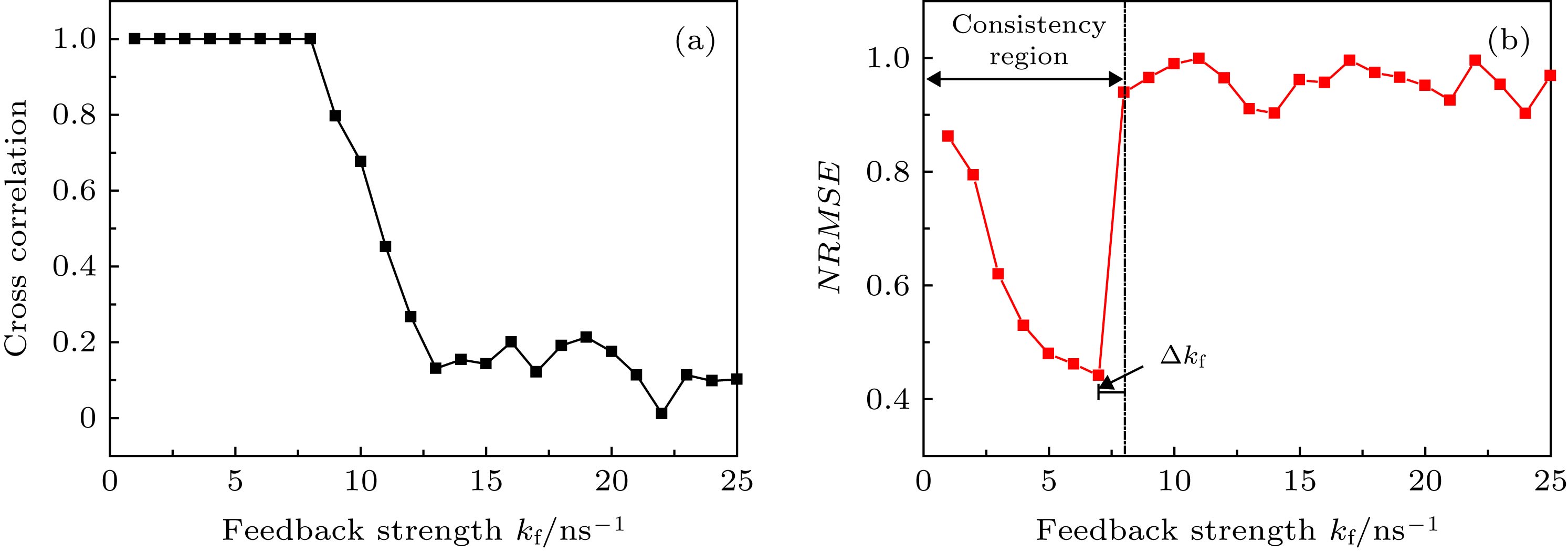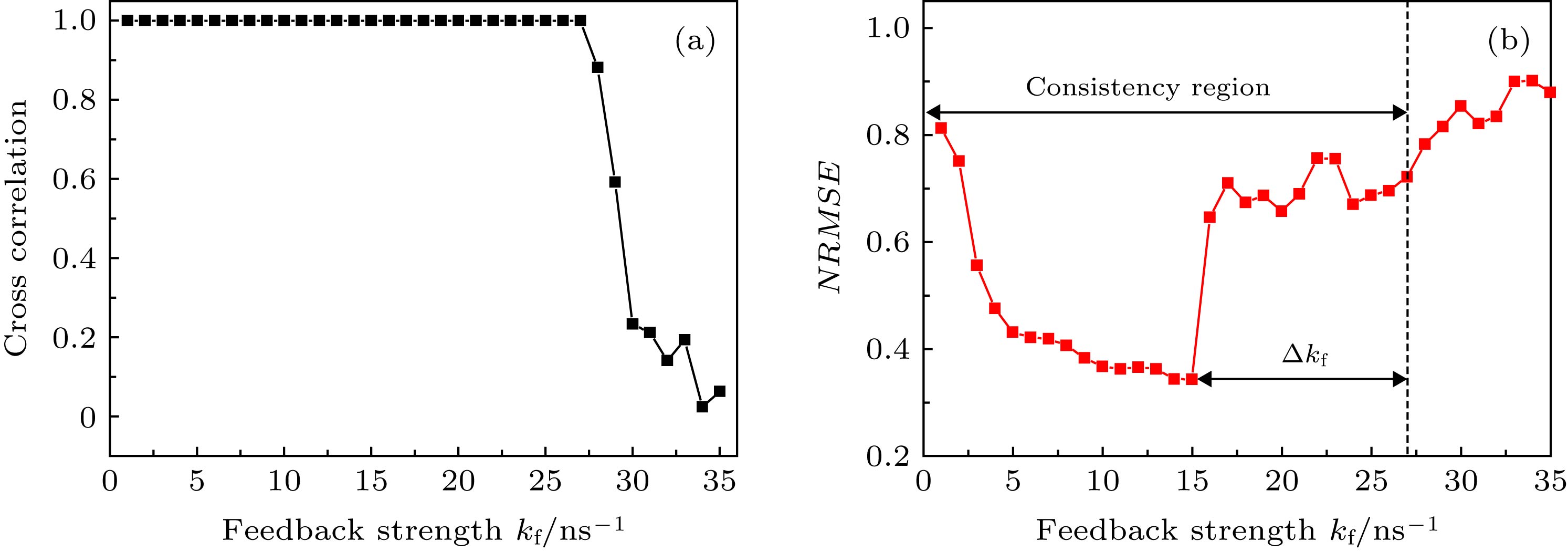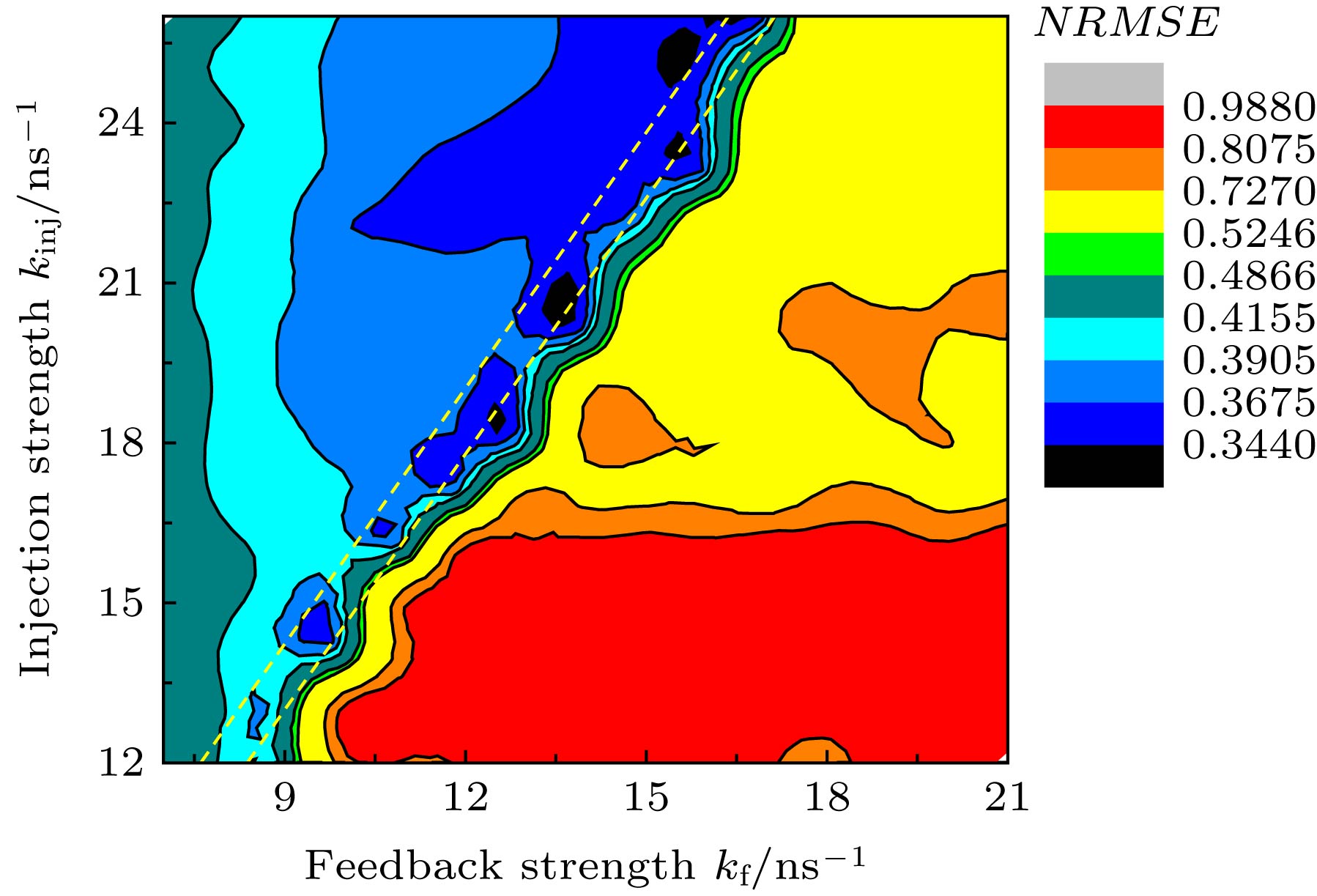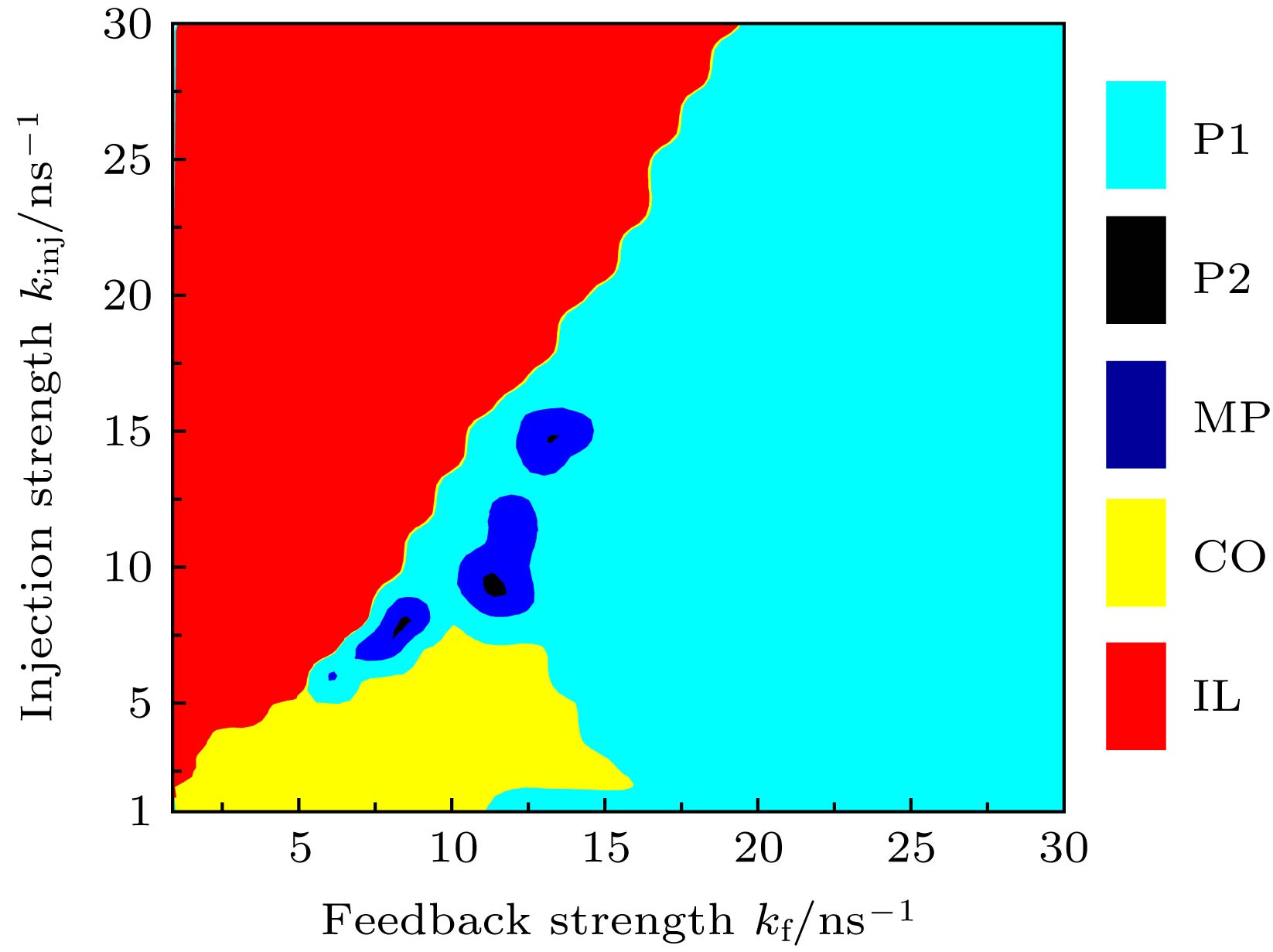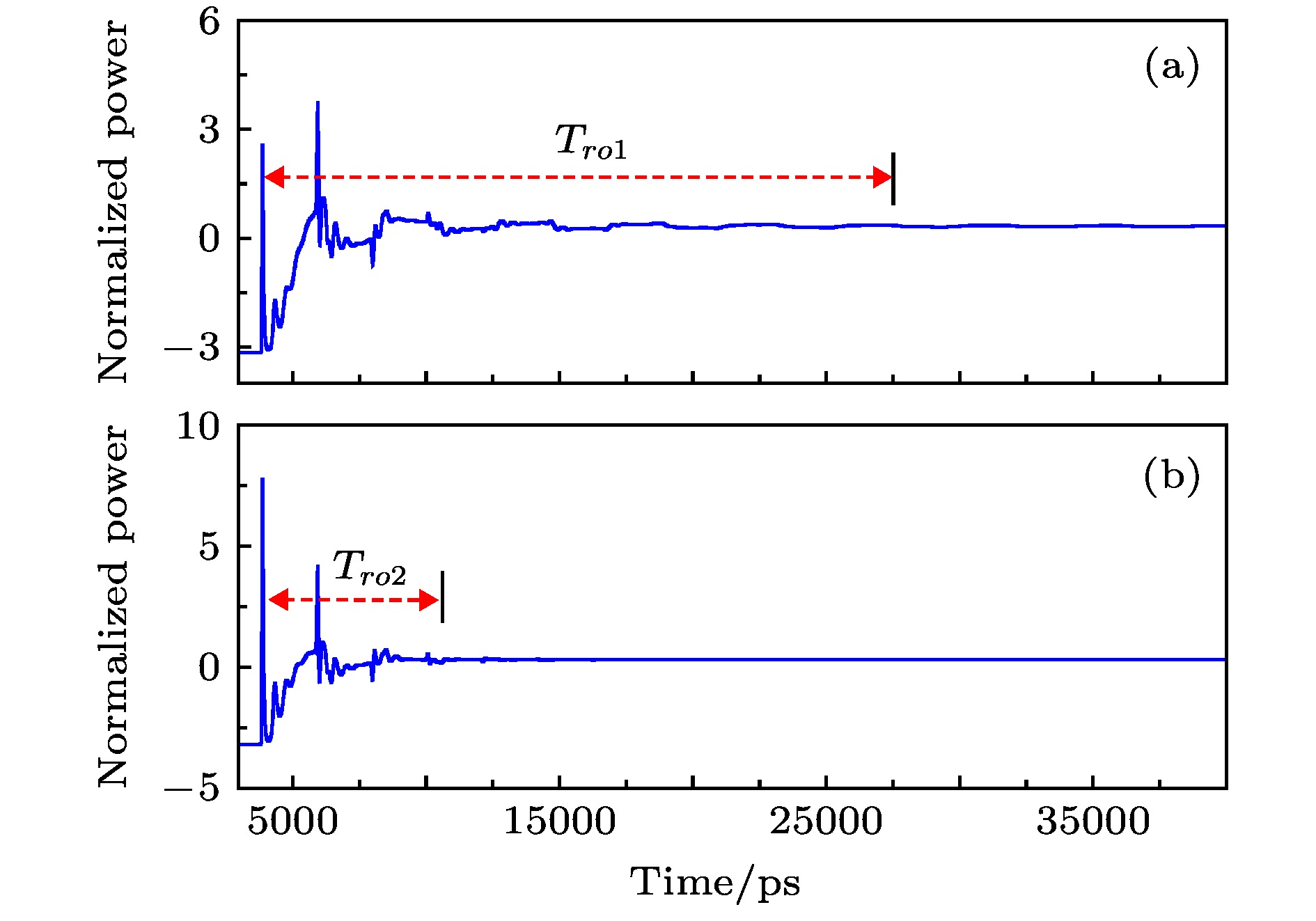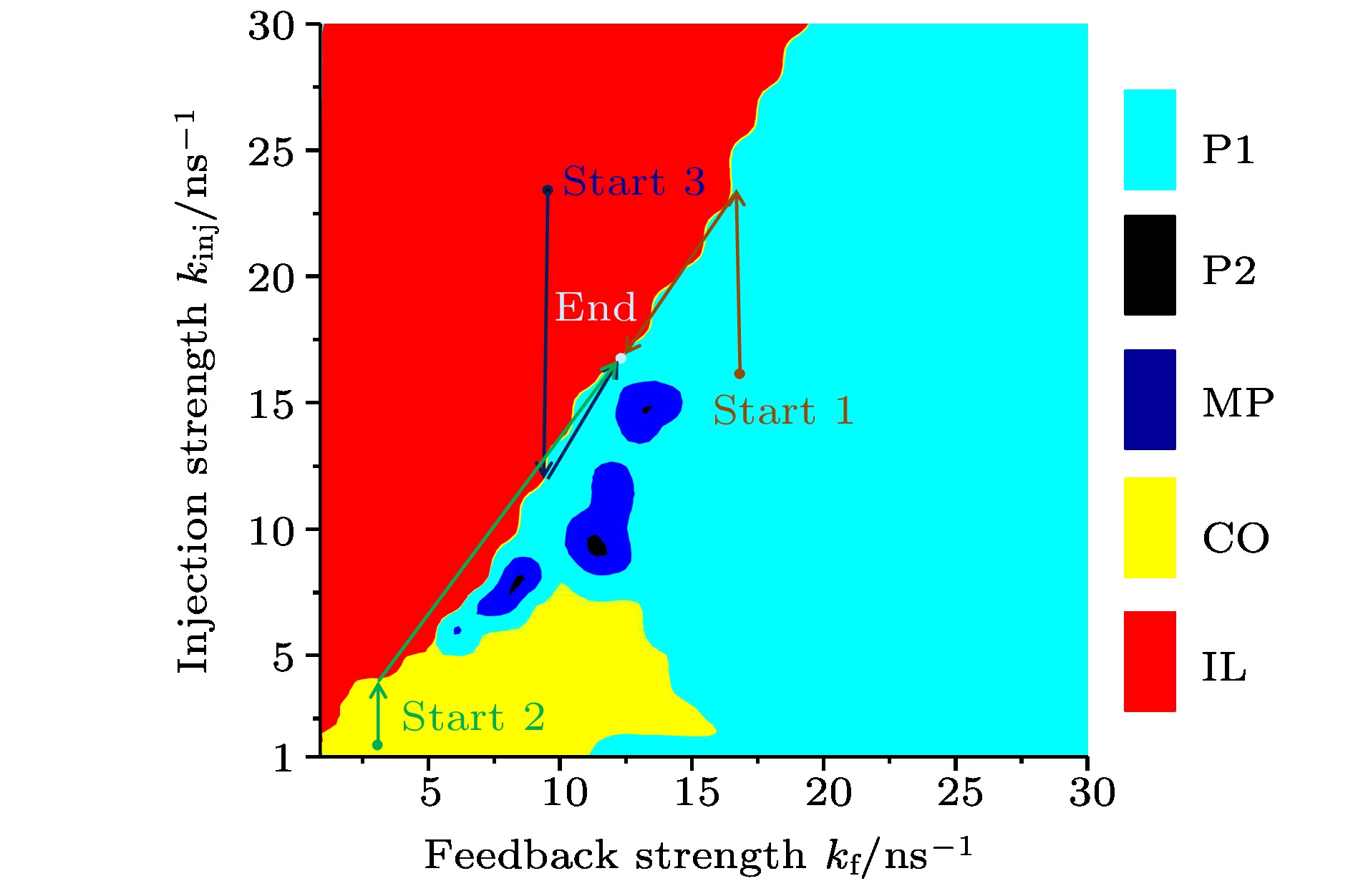-
半导体激光器储备池计算系统的性能受很多因素的影响, 如虚节点间隔、激光器的偏置电流和反馈强度等. 对于光注入信号方式, 注入强度和频率失谐的大小也会影响系统的性能, 使得工作点更难确定. 为此, 本文以10阶非线性自回归移动平均任务为基础, 提出一种选取半导体激光器储备池计算系统的最佳反馈强度与注入强度的方法. 该方法通过寻找在某一反馈强度和连续光注入条件下, 对应于储备池的注入锁定状态的最小注入强度来确定注入锁定状态的边缘; 沿此边缘, 通过测试系统性能选取最佳反馈强度以及与之配套的注入强度. 综合前人对其他参数的研究, 进一步提出完整工作点参数的选取方法. 在所选取的工作点参数下, 仅用50个虚节点即获得低至0.3431的归一化均方根误差, 说明所提出的工作点选取方法是可行的. 通过混沌时间序列预测和手写数字识别任务, 验证了该方法对回归和分类问题的通用性.
-
关键词:
- 半导体激光器储备池计算系统 /
- 注入锁定 /
- 反馈强度 /
- 注入强度
Reservoir computing (RC) is an improved recurrent neural network with the simplified training process, therefore has broad application prospects. The RC can be implemented in hardware based on a nonlinear physical node and a delay feedback loop. Among the optical implementation schemes, the RC system based on semiconductor lasers can process information at high speed due to the inherently short time scales. However, the performance of the RC system, especially using the optical injection way of input signals, is affected by many factors, such as the virtual node interval, bias current, frequency detuning, feedback strength, injection strength, etc. The first three parameters can be reasonably set according to the existing studies. The feedback strength and injection strength are mostly determined through multiple attempts, and there is no method to follow, which brings great uncertainty to the RC. Although some researchers suggest that the optimal feedback strength is at the edge of consistency, the conclusion is only reached at some specific injection strengths, and nobody knows whether it is still valid when the injection strength and feedback strength change at the same time. Therefore, in this paper we investigate numerically the relationships between the optimal feedback strength and the consistency region under different injection strengths, based on the nonlinear auto regressive moving average of the 10th order (NARMA10) task. It is found that the optimal feedback strength is independent of the edge of consistency when the injection strength is large. Further research shows that the best performance of the RC system occurs at the edge of the injection locking states of the reservoir under the injection of continuous waveform light, different injection strengths and feedback strengths. Therefore this paper presents a method to select the optimal feedback strength and injection strength by using the edge of injection locking states of the reservoir under the injection of continuous waveform light. The method determines the edge of the injection locking states by searching the minimum injection strength for the injection locking states of the reservoir under one feedback strength and the injection of continuous waveform light. Then, along this edge, the optimal feedback strength and the matching injection strength are found by testing the system performance. Based on existing studies of other parameters, a method to select all parameters at the operating point is proposed. For the NARMA10 task, the normalized root mean square error at the operating point selected is as low as 0.3431 only by using 50 virtual nodes, showing that the proposed method of selecting operating point is feasible. From three properties of reservoirs, the reasons for the best performance of the system under these parameters are explained. The universality of this method for regression and classification task is tested by chaotic time series prediction task and handwritten digit recognition task. The results show that the two tasks can achieve good performance under the operating point selected by this proposed method, which verifies the universality of the method.-
Keywords:
- reservoir computing system based on semiconductor lasers /
- injection locking /
- feedback strength /
- injection strength
[1] Lin F Y, Liu J M 2003 Opt. Commun. 221 173
 Google Scholar
Google Scholar
[2] Hwang S K, Liu J M 2000 Opt. Commun. 183 195
 Google Scholar
Google Scholar
[3] Delfyett P J, Gee S, Choi M T, Izadpanah H, Yilmaz T 2006 J. Lightwave Technol. 24 2701
 Google Scholar
Google Scholar
[4] Juan Y S, Lin F Y 2009 Opt. Lett. 34 1636
 Google Scholar
Google Scholar
[5] Annovazzi-Lodi V, Donati S, Scire A 1996 IEEE J. Quantum. Elect. 32 953
 Google Scholar
Google Scholar
[6] Jiang N, Zhao A, Xue C, Tang J, Qiu K 2019 Opt. Lett. 44 1536
 Google Scholar
Google Scholar
[7] Zhao A, Jiang N, Liu S, Xue C, Tang J, Qiu K 2019 Opt. Express 27 12336
 Google Scholar
Google Scholar
[8] Wang D M, Wang L S, Guo Y Y, Wang Y C, Wang A B 2019 Opt. Express 27 3065
 Google Scholar
Google Scholar
[9] Wang Y, Xiang S, Wang B, Cao X, Wen A, Hao Y 2019 Opt. Express 27 8446
 Google Scholar
Google Scholar
[10] Brunner D, Soriano M C, Mirasso C R, Fischer I 2013 Nat. Commun. 4 1364
 Google Scholar
Google Scholar
[11] Appeltant L, Soriano M C, Van D S G, Danckaert J, Massar S, Dambre J, Schrauwen B, Mirasso C R, Fischer I 2011 Nat. Commun. 2 468
 Google Scholar
Google Scholar
[12] Larger L, Soriano M C, Brunner D, Appeltant L, Gutierrez J M, Pesquera L, Mirasso C R, Fischer I 2012 Opt. Express 20 3241
 Google Scholar
Google Scholar
[13] Duport F, Schneider B, Smerieri A, Haelterman M, Massar S 2012 Opt. Express 20 22783
 Google Scholar
Google Scholar
[14] Dejonckheere A, Duport F, Smerieri A, Fang L, Oudar J L, Haelterman M, Massar S 2014 Opt. Express 22 10868
 Google Scholar
Google Scholar
[15] Hicke K, Escalona-Morán M A, Brunner D, Soriano M C, Fischer I, Mirasso C R 2013 IEEE J Sel. Top. Quant. 19 1501610
 Google Scholar
Google Scholar
[16] Nguimdo R M, Verschaffelt G, Danckaert J, Danckaert J, Sande G V D 2014 Opt. Express 22 8672
 Google Scholar
Google Scholar
[17] Oliver N, Jüngling T, Fischer I 2015 Phys. Rev. Lett. 114 123902
 Google Scholar
Google Scholar
[18] Nakayama J, Kanno K, Uchida A 2016 Opt. Express 24 8679
 Google Scholar
Google Scholar
[19] Qin J, Zhao Q, Xu D, Yin H, Chang Y, Huang D 2016 Mod. Phys. Lett. B 30 1650199
[20] Fischer I, Bueno J, Brunner D, Soriano M C, Mirasso C R 2016 Proceedings of the 42 nd European Conference on Optical Communication Dusseldorf, Germany, September 18−22, 2016 p336
[21] Bueno J, Brunner D, Soriano M C 2017 Opt. Express 25 2401
 Google Scholar
Google Scholar
[22] Hou Y S, Xia G Q, Yang W Y, Wang D, Jayaprasath E, Jiang Z F, Hu C X, Wu M Z 2018 Opt. Express 26 10211
 Google Scholar
Google Scholar
[23] Argyris A, Bueno J, Fischer I 2018 Sci. Rep. 8 8487
 Google Scholar
Google Scholar
[24] Lang R, Kobayashi K 1980 IEEE J. Quantum. Elect. 16 347
 Google Scholar
Google Scholar
[25] Deng L 2012 IEEE Signal. Proc. Mag. 29 141
-
表 1 部分仿真参数
Table 1. Partial simulation parameters.
Symbols Parameters Values α Linewidth enhancement factor 3.0 G Gain coefficient 8.4 × 10–13 m3s–1 N0 Carrier density at transparency 1.4 × 1024 m–3 ε Gain saturation coefficient 2.0 × 10–23 τp Photon lifetime 1.927 ps τs Carrier lifetime 2.04 ns Jth Threshold current of the response laser 9.892 × 1032 m–3s–1 ω Free-running angular frequency of the response laser 1.23 × 1015 rad/s Id Output optical intensity of the drive laser 5. 65 × 1020 W/m2 -
[1] Lin F Y, Liu J M 2003 Opt. Commun. 221 173
 Google Scholar
Google Scholar
[2] Hwang S K, Liu J M 2000 Opt. Commun. 183 195
 Google Scholar
Google Scholar
[3] Delfyett P J, Gee S, Choi M T, Izadpanah H, Yilmaz T 2006 J. Lightwave Technol. 24 2701
 Google Scholar
Google Scholar
[4] Juan Y S, Lin F Y 2009 Opt. Lett. 34 1636
 Google Scholar
Google Scholar
[5] Annovazzi-Lodi V, Donati S, Scire A 1996 IEEE J. Quantum. Elect. 32 953
 Google Scholar
Google Scholar
[6] Jiang N, Zhao A, Xue C, Tang J, Qiu K 2019 Opt. Lett. 44 1536
 Google Scholar
Google Scholar
[7] Zhao A, Jiang N, Liu S, Xue C, Tang J, Qiu K 2019 Opt. Express 27 12336
 Google Scholar
Google Scholar
[8] Wang D M, Wang L S, Guo Y Y, Wang Y C, Wang A B 2019 Opt. Express 27 3065
 Google Scholar
Google Scholar
[9] Wang Y, Xiang S, Wang B, Cao X, Wen A, Hao Y 2019 Opt. Express 27 8446
 Google Scholar
Google Scholar
[10] Brunner D, Soriano M C, Mirasso C R, Fischer I 2013 Nat. Commun. 4 1364
 Google Scholar
Google Scholar
[11] Appeltant L, Soriano M C, Van D S G, Danckaert J, Massar S, Dambre J, Schrauwen B, Mirasso C R, Fischer I 2011 Nat. Commun. 2 468
 Google Scholar
Google Scholar
[12] Larger L, Soriano M C, Brunner D, Appeltant L, Gutierrez J M, Pesquera L, Mirasso C R, Fischer I 2012 Opt. Express 20 3241
 Google Scholar
Google Scholar
[13] Duport F, Schneider B, Smerieri A, Haelterman M, Massar S 2012 Opt. Express 20 22783
 Google Scholar
Google Scholar
[14] Dejonckheere A, Duport F, Smerieri A, Fang L, Oudar J L, Haelterman M, Massar S 2014 Opt. Express 22 10868
 Google Scholar
Google Scholar
[15] Hicke K, Escalona-Morán M A, Brunner D, Soriano M C, Fischer I, Mirasso C R 2013 IEEE J Sel. Top. Quant. 19 1501610
 Google Scholar
Google Scholar
[16] Nguimdo R M, Verschaffelt G, Danckaert J, Danckaert J, Sande G V D 2014 Opt. Express 22 8672
 Google Scholar
Google Scholar
[17] Oliver N, Jüngling T, Fischer I 2015 Phys. Rev. Lett. 114 123902
 Google Scholar
Google Scholar
[18] Nakayama J, Kanno K, Uchida A 2016 Opt. Express 24 8679
 Google Scholar
Google Scholar
[19] Qin J, Zhao Q, Xu D, Yin H, Chang Y, Huang D 2016 Mod. Phys. Lett. B 30 1650199
[20] Fischer I, Bueno J, Brunner D, Soriano M C, Mirasso C R 2016 Proceedings of the 42 nd European Conference on Optical Communication Dusseldorf, Germany, September 18−22, 2016 p336
[21] Bueno J, Brunner D, Soriano M C 2017 Opt. Express 25 2401
 Google Scholar
Google Scholar
[22] Hou Y S, Xia G Q, Yang W Y, Wang D, Jayaprasath E, Jiang Z F, Hu C X, Wu M Z 2018 Opt. Express 26 10211
 Google Scholar
Google Scholar
[23] Argyris A, Bueno J, Fischer I 2018 Sci. Rep. 8 8487
 Google Scholar
Google Scholar
[24] Lang R, Kobayashi K 1980 IEEE J. Quantum. Elect. 16 347
 Google Scholar
Google Scholar
[25] Deng L 2012 IEEE Signal. Proc. Mag. 29 141
计量
- 文章访问数: 11420
- PDF下载量: 133
- 被引次数: 0














 下载:
下载:
